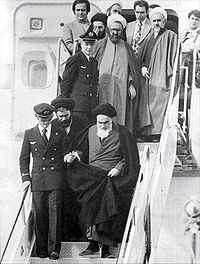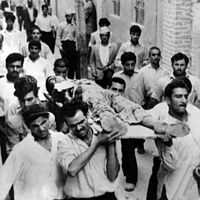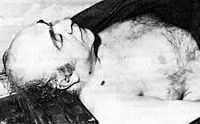Casualties of the Iranian Revolution
Part of a series on the |
|---|
| History of the Iranian Revolution |
 |
|
Topics
|
|
Revolutionary leaders
|
|
|
Official institutions
|
|
Events
|
|
See also |
Observers differ on how many people died during the Iranian Revolution. The number of casualties suffered by protesters and revolutionaries at the hands of the Shah's regime during the revolution is either close to 60,000, or around 3000, depending on whether the estimates used are those of Islamic government or from historians in Western countries. The number of protesters and political prisoners killed by the new Islamic regime after the fall of the Shah is estimated by human rights groups to be several thousand.
Casualties of the monarchy

.jpg)
Ayatollah Ruhollah Khomeini, the leader of the revolution, stated that "60,000 men, women and children were martyred by the Shah's regime,"[1] and this number appears in the constitution of the Islamic Republic.[2]
More recently, tabulation by Emadeddin Baghi, a researcher at the Martyrs Foundation (Bonyad Shahid) found a far lower number of casualties. Baghi found that between 1963 and 1979, there were 3164 dead among the anti-Shah movement.[1][3] In Iran, the Martyrs Foundation, established after the revolution to compensate the survivors of fallen revolutionaries, could identify only 744 martyrs in Tehran, where the majority of the casualties were supposed to have occurred. The coroner's office and Tehran's main cemetery, Behesht-e Zahra, counted 895 and 768 martyrs, respectively.[4]
By date
According to one collection of `martyrs of the revolution,`
- 35 demonstrators died in the first eight months of 1978,
- 33 in Shahrivar (August–September 1978) and
- 18 in Mehr (September–October 1978), when the revolution turned to strikes instead of street protests.
When the military regime was installed in Mehr 1978, the number of deaths jumped to
- 45 in Aban (October–November 1978), then to
- 85 in Azar (November–December 1978),
- 137 in Dey (December 1978-January 1979), and
- 179 in Bahman (January–February 1979).[5]
19 Dey protest in Qom
The 9 January 1978 (Dey 19, 1356) protest in the holy city of Qom against a libelous story about the Ayatollah Khomeini was perhaps the first major protest of the revolution. The official death toll of monarchy was nine. U.S. diplomats first reported to Washington that 20 to 30 died, then fourteen. Rumors spread immediately that one hundred or more were killed, and "opposition estimates ranged up to 300." Public opinion at the time as reflected in "a small survey in Tehran the following week" found that "more people believed the opposition's casualty figures than the government's".[6]
But a list recently produced by the Center for Documents on the Islamic Revolution, a "pro-revolutionary institute" found five people died in the protest.[7]
29 Bahman protest in Tabriz
40 days later, on 18 February 1978, (Bahman 29), groups in a number of cities marched to honour the fallen and protest against the rule of the Shah. The state brought in "troops and tanks from nearby bases." This time, violence erupted in the northwestern city of Tabriz, were according to the opposition five hundred demonstrators were killed, ten according to the government. "A recent pro-revolutionary review of the event, however, have stated definitively that the total was 13 dead."[8]
"Black Friday," 17 Shahrivar
The clash between government and protestors that is said to have enraged anti-Shah forces and eliminated "any hope for compromise," occurred on 8 September 1978 (Shahrivar 17) in Tehran. The Shah introduced martial law, and banned all demonstrations but thousands of protesters gathered in Tehran. Security forces shot and killed demonstrators, in what became known as Black Friday.
The clerical leadership declared that "thousands have been massacred by Zionist troops,"[9] "Estimate of casualties on ... Black Friday, range from fewer than 100 to many thousands. The post-revolutionary Martyr Foundation could identify only 79 dead, while the coroner's office counted 82 and Tehran's main cemetery, Beheshte-e Zahra, registered only 40."[10]
Explanation
One explanation for the low number of casualties is the shah's reluctance to use force. The shah "frequently" insisted to "foreign emissaries" that he was "unwilling to massacre his subjects in order to save his throne." `"The instructions I gave were always the same: "do the impossible to avoid bloodshed."` While this claim was at odds with "the image of vast masses standing up to machine-gun fire" at the time of the revolution, various military officials have since "corroborated" it according to author Charles Kurzman
During the course of 1978, a martial law commander allegedly proposed to bomb Qom. An Air Force general supposedly offered to kill a hundred thousand protesters to quell the disturbances. A SAVAK general regaled a guest from the CIA `with some fairly bloodthirsty details of how he could have put an end to the demonstrations within a week if only the Shah had given him free rein.`The head of a neighboring country suggested the execution of 700 mullahs. .... The Shah vetoed all these plans.[11]
Casualties of the Islamic government
Following the overthrow of the Shah's government on 11 February 1979 (22 Bahman 1357), members of the old regime, including senior generals, were executed by revolutionary leadership. For this aim, the Islamic regime formed komitehs (committees) in all provinces.[12] Ayatollah Mohammad Reza Mahdavi Kani was the chief of the Central Provisional Komiteh for the Islamic Revolution.[12] The komitehs were lack of necessary mechanism and legal procedure, leading to restructuring on 8 March 1979.[12]
In the first couple of months, over 200 of the Shah's senior civilian officials were killed as punishment and to eliminate the danger of coup d'état.[13] The first death sentences were approved by the Tehran court on four of the shah's generals on February 1979.[14] They were Mehdi Rahimi, the military commander of Tehran, Reza Naji, the military governor of Isfahan, Nematollah Nassiri, the head of SAVAK, and Manuchehr Khosrodad, an air force general. All four generals were executed by firing squad on the roof of the then Ayatollah Khomeini's headquarters on 15 February.[14]
On 7 April 1979, Amir-Abbas Hoveyda, former prime minister of Iran, was executed.[14] Two days later on 9 April ten senior officials of the Shah, including two generals and a cabinet member, were executed in Tehran.[15] Those killed included commander-in-chief of the air force, Amir Hossein Rabi'i.[15] On 11 April, former foreign minister, Abbas Ali Khalatbari, and 10 more officials were executed in Tehran.[16] On 8 May, a total of 21 former Iranian officials, including three former high-level politicians, were executed. They were Javad Saeed, former Majlis speaker, Gholam Reza Kianpor, former information minister, and Mohammad Reza Ameli Tehrani, former education minister.[17] On 9 May, eight men, including a prominent Jewish executive, and former information minister, Abdul Hassan Saadatmand, were executed, raising the number of the executed people 119 since February 1979.[18] On 23 July 1979, five more men were executed in the Khuzestan province.[19] The death toll became 363 with these executions since February 1979.[19] In August 1979, the courts began to try the members of the ethnic minorities in the country who participated in anti-government demonstrations, and the trials resulted in massive death sentences.[14] By November 1979, the death toll was 550[14] and by January 1980, the number had reached at least 582.[20]
Critics complained that the brief trials lacked defense attorneys, juries, transparency or opportunity for the accused to defend themselves,[21] were held by revolutionary judges such as Sadegh Khalkhali, the Sharia judge. Those who escaped Iran were not immune. A decade later, another former Prime Minister, Shapour Bakhtiar, was assassinated in Paris, one of at least 63 Iranians abroad killed or wounded since the Shah was overthrown,[22] although these attacks are thought to have stopped after the early 1990s.[23]
The pace of executions then accelerated, leading to at least 906 executions between January 1980 and June 1981.[24] After president Abulhassan Banisadr was impeached on 20 June 1981 (30 Khordad 1360), a concerted effort was made to find and prosecute the erstwhile supporters turned opposition, primarily leftists. Bloodletting became much worse. According to Shaul Bakhash,
The number who lost their lives will probably never be known with certainty. Amnesty International documented 2,946 executions in the 12 months following Bani-Sadr's impeachment. A list compiled the following year by the Mojahedin-e Khalq cited 7,746 persons who had lost their lives through executions, in street battles, or under torture in the short period from June 1981 to September 1983.[25]
According to historian Ervand Abrahamian, revolutionary courts executed more than 8000 opponents between June 1981 and June 1985. These were mainly members of the Mojahedin-e Khalq, but also included
Fedayins and Kurds as well as Tudeh, National Front, and Shariatmadari supporters. ... Thus the toll taken among those who had participated in the revolution was far greater than that of royalists. This revolution — like others — had devoured its own children.[26]
See also
- Human rights in Islamic Republic of Iran
References
- ↑ 1.0 1.1 A Question of Numbers Web: IranianVoice.org 8 August 2003 Rouzegar-Now Cyrus Kadivar
- ↑ The Constitution of Islamic Republic of Iran. The price the nation paid
- ↑ E. Baqi, `Figures for the Dead in the Revolution`, Emruz, 30 July 2003
- ↑ Kurzman, Charles, The Unthinkable Revolution in Iran, (Harvard University Press, 2004), p.71
- ↑ Kurzman, Unthinkable Revolution, (2004), p.109.
sources: "On martyrs of the revolution see Laleh'he-ye Enqelab; this volume, published by a religious institution, features photographs of `martyrs of the revolution,` including name, age, date and place of death, and sometimes occupation; the method of selection is not described. I am indebted to Prof. James A. Bill for directing me to Laleh'ha-ye Enqelab, which he too has used as sampling of revolutionary fatalities (Bill, James, The Eagle and the Lion, p.487 - ↑ Kurzman, Unthinkable Revolution, (2004), p.37
- ↑ Kurzman, Unthinkable Revolution, (2004), p.37
- ↑ Kurzman, The Unthinkable Revolution in Iran, (2004), p.46 [for definitive fatality counts see Shirkhani, Hamaseh-ye 29 Bahman, 143-176; Enqelab-e Eslami Beh Ravayet-e Asnad-e SAVAK, v.3, 37, note 1] (Kurzman, Unthinkable Revolution, (2004), p.201
- ↑ Taheri, The Spirit of Allah (1985), p. 223.
- ↑ Kurzman, Unthinkable Revolution, (2004), p.75
- ↑ Kurzman, Unthinkable Revolution, (2004), p.108
- ↑ 12.0 12.1 12.2 "Law And Human Rights in the Islamic Republic of Iran" (REPORT). Amnesty International. 13 March 1980. Retrieved 3 August 2013.
- ↑ Moin, Khomeini, 2000, p. 208.
- ↑ 14.0 14.1 14.2 14.3 14.4 "Iran after the victory of 1979's Revolution". Iran Chamber Society. Retrieved 26 July 2013.
- ↑ 15.0 15.1 "Firing squads kill 10 in Iran". The Dispatch (Tehran). AP. 9 April 1979. Retrieved 30 July 2013.
- ↑ "Iran court testimony". The Montreal Gazette (Tehran). UPI. 12 April 1979. Retrieved 25 July 2013.
- ↑ "21 Shah officials executed in Iran". Toledo Blade. 8 May 1979. Retrieved 4 November 2012.
- ↑ "8 more menput to death in Iran;toll climbs to 119". Toledo Blade. 9 May 1979. Retrieved 4 November 2012.
- ↑ 19.0 19.1 "5 Iranians executed in oil-rich province". Toledo Blade (Tehran). AP. 23 July 1979. Retrieved 4 November 2012.
- ↑ Mackay, Iranians , p. 291
- ↑ Bakhash, The Reign of the Ayatollahs (1984), p. 61.
- ↑ Mackay, Iranians, 1996, p. 373.
- ↑ Keddie, Modern Iran, (2003), p. 268
- ↑ Source: Letter from Amnesty International to the Shaul Bakhash, 6 July 1982. Quoted in The Reign of the Ayatollahs by Shaul Bakhash, p. 111
- ↑ list compiled by the Mojahedin quoted in The Reign of the Ayatollahs by Shaul Bakhash, pp. 221-222
- ↑ Abrahamian, Ervand, History of Modern Iran, Columbia University Press, 2008, p. 181
Bibliography
- Keddie, Nikki, Modern Iran : Roots and Results of Revolution by Nikki Keddie, Yale University Press, 2003
- Mackey, Sandra The Iranians : Persia, Islam and the Soul of a Nation, New York : Dutton, c1996.
- Taheri, Amir, The Spirit of Allah: Khomeini and the Islamic Revolution, Adler and Adler, c1985
